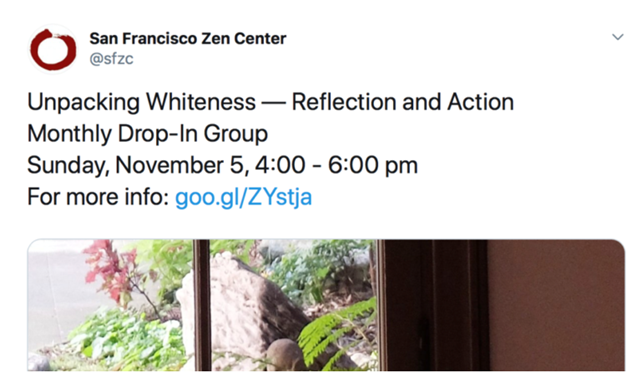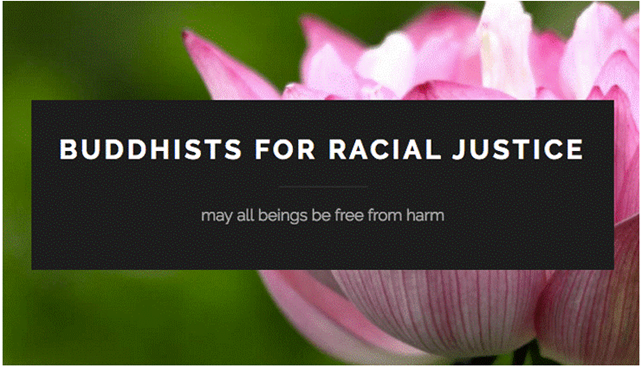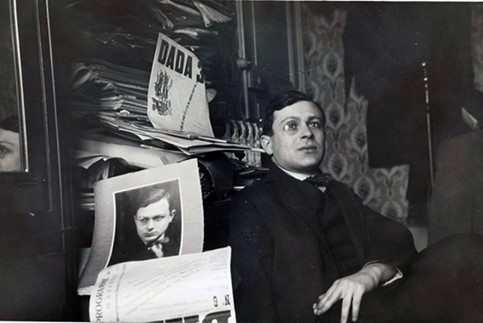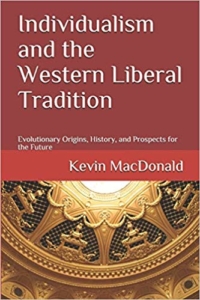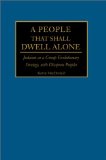Tristan Tzara și rădăcinile evreiești ale Dada – Partea 1 din 3
12 aprilie 2023/ în Articole recomandate, Civilizația occidentală, Cultura occidentală
de Brenton Sanderson; tradus de C.D.
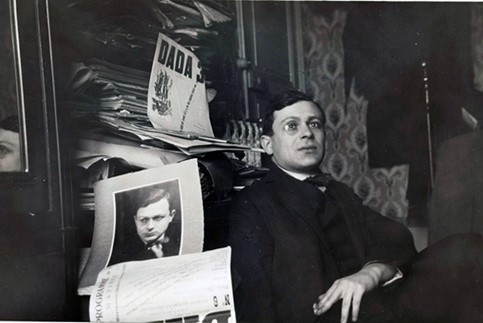
Tristan Tzara (Samuel Rosenstock)
Secolul XX a văzut o proliferare a artei inspirată de cultura critică evreiască. Expunerea și promovarea acestei arte au crescut odată cu pătrunderea evreiască și eventuala capturare a instituției de artă occidentală. Artiștii evrei au căutat să rescrie regulile de exprimare artistică – pentru a se adapta propriilor limitări tehnice și pentru a facilita crearea (și acceptarea de către elită) a lucrărilor menite ca o mustrare la normele civilizației occidentale.
Substructura intelectuală evreiască a multora dintre aceste mișcări artistice din secolul al XX-lea s-a manifestat prin ostilitatea lor nesfârșită față de tradițiile politice, culturale și religioase ale Europei și ale societăților derivate din Europa. Am examinat cum ascensiunea expresionismului abstract a exemplificat această tendință în Statele Unite și a coincis cu uzurparea instituției artistice americane de către un grup de intelectuali evrei radicali.
În Europa, influența evreiască asupra artei occidentale a atins apogeul în anii interbelici. Această epocă, când munca multor artiști reflectă politica lor radicală, a fost perioada de glorie a avangardei evreiești.
Un exemplu proeminent de mișcare culturală din această perioadă cu o importantă implicare evreiască a fost Dada. Dadaiștii au contestat însăși bazele civilizației occidentale pe care le considerau patologice, în contextul distrugerii Primului Război Mondial și al antisemitismului continuu în toată Europa.
Artiștii și intelectualii Dada au răspuns acestui diagnostic socio-politic cu diverse acte de subversiune culturală. Dada a fost o mișcare distructivă și nihilistă, irațională și absurdă și care a predicat răsturnarea oricărei tradiții culturale din trecutul european, inclusiv raționalitatea însăși. Dadaiștii „au țintă să ștergă tabelul filozofic” și să conducă „calea către o nouă ordine mondială.”[1]
Deși în Dada erau mulți non-evrei implicați, contribuția evreiască a fost fundamentală pentru modelarea progresului său intelectual ca mișcare, pentru Dada a fost la fel de mult o atitudine și un mod de a gândi ca și un mod de producție artistică.
Scriind pentru The Forward, Bill Holdsworth a observat că Dada „a fost una dintre mișcările artistice cele mai radicale care au atacat societatea burgheză” și că „epiccentul a ceea ce va deveni o mișcare distinctă… se aflau evreii români, în special Marcel și Georges Janco. și Tristan Tzara — care au fost esențiale pentru dezvoltarea spiritului Dada.”[2]
Pentru Menachem Wecker, lucrările dadaiștilor evrei au reprezentat „nu doar răspunsurile estetice ale indivizilor opuse absurdității războiului și fascismului”, ci, invocând tema bine-purtată „lumină pentru națiuni”, insistă că au adus o „perspectivă deosebit de evreiască insistenței asupra justiției și a ceea ce se numește acum tikkun olam”. În consecință, pentru Wecker, „nu pare o coincidență faptul că atât de mulți dintre artiștii Dada au fost evrei.”[3]
Nu pare coincidență când aflăm că Dada a fost un eveniment cu adevărat internațional, nu doar pentru că a operat peste granițele politice, ci pentru că a atacat în mod conștient naționalismul patriotic.
Dada a căutat să depășească granițele naționale și să deradă ideologiile naționaliste europene, iar în cadrul acestei comunități de artiști în exil (o „diasporă dublă” în cazul dadaiștilor evrei) ceea ce a contat cel mai mult a fost efortul colectiv de a articula o atitudine de revoltă împotriva culturii europene. convenții și cadre instituționale.
În primul rând, Dada a vrut să realizeze „o mare lucrare negativă de distrugere”. Prezintându-i pe poststructuraliști și deconstrucționiști din anii șaizeci și șaptezeci, ei credeau că singura speranță pentru societate „era să distrugă acele sisteme bazate pe rațiune și logică și să le înlocuiască cu altele bazate pe anarhie, primitiv și irațional.”[4]
Robert Short observă că Dada a reprezentat „individualismul exacerbat, îndoiala universală și [un] iconoclasm agresiv” care a încercat a dezminți „canoanele tradiționale ale rațiunii, gustului și ierarhiei, ale ordinii și disciplinei în societate, ale inspirației controlate rațional în exprimarea imaginativă”. [5]
Tristan Tzara și Zurich Dada
Omul care a fondat efectiv Dada a fost poetul evreu român Tristan Tzara (născut Samuel Rosenstock în 1896). „Tristan Tzara” a fost pseudonimul pe care l-a adoptat în 1915, însemnând „trist în țara mea” în franceză, germană și română și care, potrivit lui Gale, a fost „un protest deghizat împotriva discriminării evreilor din România”.[6]
A fost Tzara care, prin scrierile sale, în special Prima aventură cerească a domnului Antipyrine (1916) și Cele șapte manifeste Dada (1924), a pus bazele intelectuale ale Dada.[7] Manifestul Dadaist al lui Tzara din 1918, a fost cel mai larg răspândit dintre toate textele Dada și „a jucat un rol cheie în articularea unui ethos dadaist în jurul căruia o mișcare ar putea să se coereze.”[8]
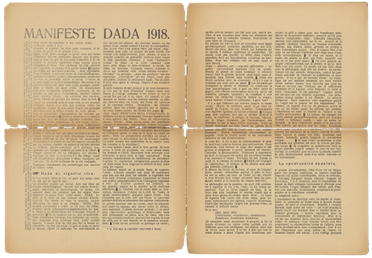
Manifestul Dada al lui Tzara din 1918
În cartea sa “Dada East: The Romanians of Cabaret Voltaire”, Tom Sandqvist notează că fundalul intelectual și spiritual al lui Tzara a fost infuzat cu subculturile idiș și hassidic ale patriei sale moldovenești de la începutul secolului al XX-lea și cum acestea au avut o importanță fundamentală în determinarea inovațiilor artistice. el avea să se instituie drept conducător al Dada.
El leagă revolta lui Tzara împotriva constrângerilor sociale europene direct de identitatea sa evreiască, iar percepția sa despre populația evreiască din România (și în special despre Moldova sa natală) a fost crunt oprimată de antisemitism. Conform legii române, familia Rosenstock, o familie de negustori prosperi de cherestea, nu s-a emancipat pe deplin. Mulți evrei ruși s-au stabilit în Moldova românească după ce au fost alungați din alte țări și au locuit acolo ca oaspeți ai evreilor locali care au devenit cetățeni români abia după Primul Război Mondial (ca o condiție pentru pace pusă de puterile occidentale).
Pentru Sandqvist, tratarea evreilor în România a alimentat o atitudine de revoltă împotriva status quo-ului socio-politic din Tzara, iar acest lucru era pe deplin în concordanță cu impulsurile anarhiste pe care le-a expus la Cabaret Voltaire din Zurich și mai târziu la Paris.
De acord cu această teză, poetul evreu etnocentric și istoric dadaist, Andrei Codrescu, susține că antisemitismul presupus omniprezent suferit de evreii români precum Tzara se extinde până în zilele noastre, insistând: „Rosenstockii erau evrei într-un oraș antisemit care pană in această zi nu listează pe site-ul său fondatorul Dada printre notabilii născuți acolo.” Acest lucru este considerat cu atât mai flagrant cu cât, în ciuda marginalității sale, orașul natal al lui Tzara, Moinești, este, în opinia lui Codrescu, „centrul lumii moderne, nu numai datorită invenției Dada de către Tristan Tzara, ci pentru că evreii săi au fost printre primii sionişti, iar Moineștiul însuși a fost punctul de plecare al unui faimos exod al oamenilor săi pe jos de aici în țara viselor, Eretz-Israel.”
Pentru Codrescu, moștenirea evreiască a lui Tzara a fost de o importanță profundă în modelarea contribuției sale la Dada.
Tatăl lui Dada a fost primit la bar mitzvah în 1910 în comunitatea hassidică din Moinești-Bacău de către renumitul rabin Bezalel Zeev Safran, tatăl marelui rabin șef Alexandre Safran, care i-a văzut pe evreii din România in cea mai întunecată oră din timpul lor, regimul fascist și al doilea război mondial.
Bunicul lui Sammy Rosenstock a fost rabinul de la Cernowitz, locul de naștere al multor scriitori evrei străluciți, inclusiv Paul Celan și Elie Weisel [amândoi au scris despre Holocaust]. … Tatăl lui Sammy deținea o fabrică de cherestea, iar bunicul său locuia pe o moșie mare împădurită, dar rădăcinile familiei sale erau adânc înfipte în noroiul shtetl, o lume evreiască întorsă adânc în interior.[9]
Pentru Codrescu, Tzara a fost unul dintre numeroșii „evadați shtetl” care „a văzut rapid posibilitatea revoluției” și a devenit un lider în „avangarda revoluționară a secolului XX, care a fost în mare măsură opera provincialului, evrei din Europa de Est.” În mod crucial, pentru modelarea progresului intelectual al lui Dada, Tzara și ceilalți evrei exilați de la București precum frații Janco „au adus, înfășurați în mănunchiuri de refugiați, o moștenire de secole de „ceilalti””[10]
Acest sentiment de „ceilalti” a fost făcut cu atât mai puternic din punct de vedere politic și cultural, având în vedere „marca mesianică [care] a alungat mulți evrei din interior”. Codrescu notează că: „Până la nașterea lui Samuel, în 1896, în comunitatea tradițională evreiască din Moinești se simțeau puternice curente de neliniște. Întrebările despre identitate, loc și apartenență, care au fost puse de nenumărate ori în istoria evreiască, aveau nevoie din nou de răspunsuri, de răspunsuri din secolul al XX-lea.”[11] În această nevoie de răspunsuri se aflau semințele Dada ca post-iluminism (proto-postmodern). manifestare a etno-politicii evreieşti.

Tristan Tzara în România în 1912 (extrema stângă) cu Marcel și Jules Janco (al treilea și al patrulea din stânga)
Deși există o controversă cu privire la cine a inventat exact numele „Dada”, majoritatea surselor acceptă că Tzara a nimerit cuvântul (care înseamnă divertisment în franceză) deschizând la întâmplare un dicționar francez-german. „Da-da” înseamnă, de asemenea, „da, da” în română și rusă, iar primii dadaiști s-au bucurat de calitatea primordială a sunetului său infantil și de oportunitatea sa ca simbol pentru „începerea civilizației occidentale din nou la zero”. Crepaldi remarcă faptul că alegerea numelui grupului a fost „emblematică pentru dezamăgirea și atitudinea lor, lipsită în mod deliberat de valori și referințe logice.”[12]
Tzara pare să-și fi recunoscut devreme valoarea propagandistică, poetul dadaist german Richard Huelsenbeck amintind că Tzara „a fost unul dintre primii care a înțeles puterea sugestivă a cuvântului Dada” și l-a dezvoltat ca un fel de identitate de marcă.[13]
Poezia „dadaistă” a lui Tzara a fost marcată de „incoerență semantică și sintactică extremă.”[14]
Când compunea o poezie dadaistă, tăia articolele din ziare în fragmente minuscule, le scutura într-o pungă și le împrăștia pe masă. Cum au căzut, au făcut poezia; a fost nevoie de puțină muncă suplimentară. În ceea ce privește astfel de practici, pictorul și regizorul evreu dadaist Hans Richter a comentat că „Șansa ne-a apărut ca o procedură magică prin care puteam depăși barierele cauzalității și ale voinței conștiente și prin care urechea interioară și ochiul au devenit mult mai acut. Pentru noi șansa era „mintea inconștientă”, pe care Freud o descoperise în 1900.”[15]
Codrescu speculează că poezia aleatorie a lui Tzara și-a avut probabil izvorul intelectual și estetic în cunoașterea mistică a moștenirii sale hassidice, unde Tzara a fost inspirat de: comentariile altor cabaliști celebri, cum ar fi rabinul Eliahu Cohen Itamari din Smirna, care credeau că Biblia este compusă dintr-un „amestec incoherent de litere” asupra căruia ordinea a fost impusă treptat de voința divină în funcție de diferite fenomene materiale, fără nicio influență directă a scribului sau copiatorului.
Orice fenomen terestru era capabil să rearanjeze alfabetul cosmic spre armonie cosmică. Un discipol al rabinului Smirnei a scris: „Dacă credinciosul continuă să repete zilnic, chiar și un singur verset, el poate obține mântuirea, deoarece în fiecare zi ordinea literelor se schimbă în funcție de starea și importanța fiecărei clipe…”.
Un vechi comentariu midrashic susține că repetarea zilnică chiar și a celui mai aparent nesemnificativ vers al Torei are efectul de a răspândi lumina divinității (conștiinței) la fel de mult ca orice alt verset, chiar și pe cele considerate „cel mai important”, deoarece fiecare cuvânt al Legei participă la crearea unei „lumi sănătoase”, superioară celei materiale, pe care o conduce și o organizează. Această „lume sonoră” este mai sus pe Sephiroth (pomul vieții care leagă lumile oamenilor de Dumnezeu), mai aproape de nenumăbil, fiind iluminat de divin.
Nu trebuie să ajungem mai departe pentru a vedea că credința într-o antilume autonomă făcută din cuvinte este Dada pură. În cuvintele lui Tzara, „lumina unei magii greu de atins și de abordat.”[16]
Faptul că Tzara s-a întors la studiul Cabalei spre sfârșitul vieții, dă cu siguranță greutate tezei lui Codrescu.
Finkelstein observă că poezia lui Tzara „sună ciudat ca un ritual cabalistic rescris ca un spectacol de cafenea dadaist” și leagă spiritul dadaist al lui Tzara de influența ereziilor evreiești din secolele al XVII-lea și al XVIII-lea, care s-au centrat pe noțiunea de „mântuire prin păcat”. care a implicat „încălcarea legii iudaice (uneori până la apostazie) în numele transformării mesianice”.
Poetul evreu-american Jerome Rothenberg numește aceste erezii „mișcări libertare” în cadrul iudaismului și le leagă de receptivitatea evreiască la forțele secularizării și modernității, conducând la rândul său la „rolul critic al evreilor și foștilor evrei în politica revoluționară (Marx, Troţki etc.) şi poetică de avangardă (Tzara, Kafka, Stein etc.).”
Rothenberg vede „legături istorice clare între transgresiunile mesianismului și transgresiunile avangardei.”[17] Heyd susține această teză, observând că: „Tzara folosește terminologia care face parte integrantă din gândirea iudaică și totuși supune aceste concepte. la atacul său nihilist.”[18] Poate nu este surprinzător, autorul cabalist și suprarealist Marcel Avramescu, care a scris în anii 1930, a fost inspirat direct de Tzara.
Nicholas Zarbrugg a scris studii detaliate despre modurile în care Dada a alimentat poezia sonoră și vizuală a primei faze a postmodernismului.[19] Poezia lui Tzara trebuia, de exemplu, să influențeze puternic drama absurdă a lui Samuel Beckett și poezia lui Andrei Codrescu, Jerome Rothenberg, Isidore Isue și William S. Burroughs. Allen Ginsberg, care l-a întâlnit pe Tzara la Paris în 1961, a fost puternic influențat de Tzara.
Codrescu relatează că: „Un tânăr Allen Ginsberg, așezat într-o cafenea pariziană în 1961, a văzut un Tzara sobru, în costum, trecând grăbit, purtand o servietă. Ginsburg la strigat „Hei Tzara!” dar Tzara nu s-a uitat nici măcar la el, nesimțitor față de tinerii americani neîngrijiți care invadau Parisul din nou pentru hrana culturală.”
Pentru Codrescu, a fost o tragedie minoră faptul că „taticul lui Dada nu a reușit să se conecteze cu tatăl vastei mișcări de tineret care avea să reînvie, să perfecționeze și să reînnoiască Dada în Lumea Nouă.”[20]
Cabaretul Voltaire
Cabaretul Voltaire a fost creat de poetul și pianistul anarhist german Hugo Ball la Zurich în 1916. Închiriat de la proprietarul său evreu, Jan Ephraim, și cu fonduri de pornire furnizate de o patronă evreică, Käthe Brodnitz, Cabaretul a fost înființat într-o parte a orașului și destinat ca loc de divertisment și cultură de avangardă, unde se cânta muzică, se expune lucrări de artă și se recită poezie.
O parte din această poezie a fost publicată mai târziu în periodicul Cabaretului intitulat Dada, care a devenit în curând responsabilitatea lui Tristan Tzara. În ea, el a propagat principiile derizorii dadaiste, declarând că: „Dada își folosește toată puterea pentru a stabili idiotul peste tot. Făcând-o în mod deliberat. Și tinde constant spre idioție în sine. … Noul artist protestează; nu mai pictează (aceasta este doar o reproducere simbolică și iluzorie).”[21]

Stânga: Afiș pentru Cafeneaua Voltaire, Zurich 1916 / Dreapta: Spiegelgasse 1, Zurich, Locația Cabaretului Voltaire
Serile de la Cabaret Voltaire au fost chestiuni eclectice în care „muzică nouă de Arnold Schoenberg și Alban Berg și-a luat rândul cu lecturi ale lui Jules Laforgue și Guillaume Apollinaire, demonstrații de „dans negre” și o nouă piesă a pictorului și dramaturg expresionist Oskar Kokoschka.”[ 22] Includerea dansului și muzicii a extins activitățile Dada în zone care au permis o exprimare totală care se apropie de idealul antebelic (inițial wagnerian) al Gesamtkunstwerk (opera de artă combinată).
În timp, tonul actelor „a devenit mai agresiv și mai violent și a început să se audă o polemică împotriva monotoniei burgheze.”[23] Spectacolele au căutat să șocheze atitudinile burgheze și să submineze deschis modelele spectatorilor de înțelegere a culturii. Astfel, o prelegere din iunie 1917 „despre arta modernă” a fost susținută de un lector care și-a dezbrăcat hainele în fața publicului înainte de a fi arestat și închis pentru comiterea de acte obscene în public.[24]
Godfrey notează că: „Acesta a fost carnavalul la cel mai grotesc și extrem: tot gustul și decorul care mențin societatea politicoasă a fost răsturnat.”[25] Robert Wicks:
Scenele Dada transmiteau un sentiment de haos, fragmentare, atac asupra simțurilor, absurditate, frustrare a normelor obișnuite, pastiche, spontaneitate și mecanism robotizat. Erau scene dintr-o casă de nebuni, jucate de un grup de oameni sănătoși și reflexivi care își exprimau furia și dezgustul hotărât față de lumea din jurul lor.[26]
Revoltele comise de dadaiști care atacau tradițiile și preconcepțiile artei, literaturii și moralității occidentale au fost în mod deliberat extreme și menite să șocheze, iar această tactică s-a extins dincolo de Cabaret Voltaire la gesturile cotidiene. De exemplu, Tzara, „cel mai demonic activist” al lui Dada, îi îngrozea în mod regulat pe văduvii din Zurich întrebându-I care-i drumul către bordel.
Pentru Godfrey, astfel de gesturi duc la „propaganda faptei” anarhiștilor violenți care, prin bombardamentele aleatorii și asasinatele unor figuri de autoritate, au căutat să „arată putrezirea sistemului și să șocheze acel sistem în criză”. 27]
Arnason subliniază, de asemenea, intenția ideologică serioasă din spatele unor astfel de gesturi, remarcând că: „Încă de la început, dadaiștii au dat dovadă de o seriozitate a scopului și o căutare a unei noi viziuni și conținut care depășește orice dorință frivolă de ultraj a burgheziei. … Dadaiștii din Zurich făceau o reexaminare critică a tradițiilor, premiselor, regulilor, bazelor logice, chiar și a conceptelor de ordine, coerență și frumusețe care au ghidat creația artelor de-a lungul istoriei.”[28]
La Școala evreiască din Frankfurt intelectualul Walter Benjamin, a vorbit cu admirație despre efectele șocului moral ale Dada, ca anticipând efectele tehnice ale filmului în modul în care „se atacă spectatorul”.[29]
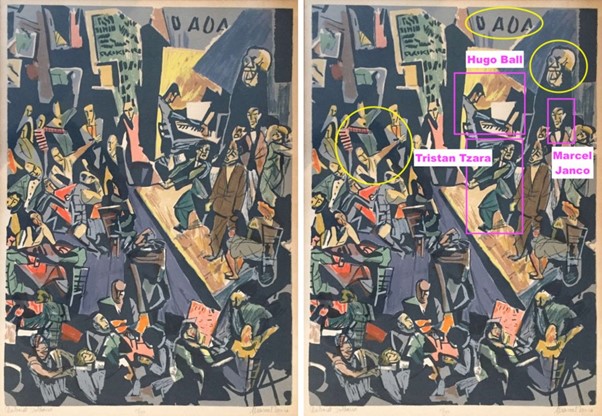
Stânga: Litografia color a unui tablou de Marcel Janco din 1916, „Cabaret Voltaire”; Dreapta: adnotări care identifică portrete ale artiștilor dada în cadrul tabloului
Conducerea Zurich Dada a trecut curând de la Ball la Tzara, care, în acest proces, „și-a impresionat negativitatea prin spiritul său anti-artistic și nihilismul său profund”.
Curând, Ball nu s-a mai putut identifica cu mișcarea și a plecat, remarcând: „Mi-am examinat conștiința cu scrupulozitate, nu am putut niciodată să salut haosul.”[30]
S-a mutat într-un mic sat elvețian și, din 1920, s-a îndepărtat de viața socială și politică, revenind la un catolicism devotat și plonjând într-un studiu al sfinților din secolele al V-lea și al VI-lea. Ball a îmbrățișat ulterior naționalismul german și urma să-i eticheteze pe evrei „o forță diabolică secretă în istoria Germaniei” și, când a analizat potențiala influență a Revoluției bolșevice asupra Germaniei, a concluzionat că „marxismul are puține perspective de popularitate în Germania, deoarece este o „Mișcarea evreiască.”[31]
Notând componența noului Comitet Executiv bolșevic, Ball a observat că:
dintre cei șase bărbați din Comitetul executiv sunt cel puțin patru evrei. Cu siguranță nu există nicio obiecție la asta; dimpotrivă, evreii au fost asupriți în Rusia prea mult timp și prea crud. Dar în afară de ideologia sincer indiferentă pe care o împărtășesc și de modul lor de gândire programatic material, ar fi ciudat dacă acești oameni, care iau decizii cu privire la expropriere și teroare, nu ar simți vechi resentimente rasiale împotriva Rusiei ortodoxe și pogromatice.[32]
Tzara, în calitate de succesor al lui Ball, a transformat rapid personajul lui Ball ca maestru de ceremonii de cabaret într-un rol de purtător de cuvânt priceput al presei cu ambiții mari. Tzara a fost „internaționalistul romantic” al mișcării, conform lui Richard Huelsenbeck în istoria sa din 1920 a Dada, „cărui zel propagandistic trebuie să-i mulțumim pentru creșterea enormă a Dada.”[33]
Pe lângă misticismul evreiesc al rădăcinilor sale hassidice, Tzara a fost puternic influențat de futuriștii italieni, deși, deloc surprinzător, a respins poziția proto-fascistă a liderului lor Marinetti. Până în 1916, dada a înlocuit futurismul ca avangarda modernismului și, potrivit dadaistului evreu Hans Richter, „am înghițit futurismul – oase, pene și tot. Este adevărat că în procesul de digestie fuseseră regurgitate tot felul de oase și pene.”[34]
Cu toate acestea, intenția dadaiștilor era contrară celei futuriștilor, care lăudau lumea mașinilor și vedeau în mecanizare, revoluție și război mijloacele logice, oricât de brutale, de a rezolva problemele umane. Dada nu a fost niciodată foarte popular în locul de naștere al futurismului, deși destul de mulți poeți italieni au devenit dadaiști, inclusiv poetul, pictorul și viitorul teoretician rasial Julius Evola, care a devenit prieten personal cu Tzara și s-a dus inițial la Dada cu un entuziasm nestăpânit.
În cele din urmă, a devenit dezamăgit de respingerea totală de către Dada a tradiției europene și a început însă căutarea unei alternative, urmând o cale de speculație filozofică care l-a condus ulterior către ezoterism și fascism.[35]
Intrarea României în război de partea Marii Britanii, Franței și Rusiei în august 1916 l-a transformat imediat pe Tzara într-un potențial recrut. Gale relatează că: „În noiembrie, Tzara a fost chemată pentru examinare de către o comisie care a stabilit capacitatea de a lupta. S-a prefăcut cu success pentru instabilitate mintală și a primit un certificat în acest sens.”[36] În acest moment, trăiau vizavi de Cabaret Voltaire din Zurich Lenin, Karl Radek și Gregory Zinoviev care se pregăteau pentru Revoluția bolșevică.
După armistițiul din noiembrie 1918, Tzara și colegii săi au început să publice un jurnal dadaist numit Der Zeltweg, menit să popularizeze Dada în vremea în care Europa se zguduia de impactul războiului, al Revoluției bolșevice, al revoltei spartaciste de la Berlin, al insurecției comuniste din Bavaria, iar, mai târziu, proclamarea Republicii Sovietice Maghiare sub Bela Kun.
Aceste evenimente, a observat Hans Richter, „au stârnit mințile oamenilor, au divizat interesele oamenilor și au deturnat energiile în direcția schimbării politice.”[37] Potrivit istoricului Robert Levy, Tzara în această perioadă asociată cu un grup de studenți comuniști români, aproape cu siguranță incluzand-o pe Ana Pauker, care mai târziu a devenit ministrul de externe al Partidului Comunist Român și unul dintre cei mai importanți și nemilos funcționari evrei ai acestuia.[38] Poeziile lui Tzara din perioadă au o orientare strident comunistă și, influențate de Freud și Wilhelm Reich, descriu violența revoluționară extremă ca un mijloc sănătos de exprimare umană.[39]
Printre ceilalți artiști și intelectuali evrei care s-au alăturat lui Tzara în Elveția neutră pentru a scăpa de implicarea în război s-au numărat pictorul și sculptorul Marcel Janco (1895-1984), frații săi Jules și George, pictorul și realizatorul de film experimental Hans Richter (1888-1976), eseistul Walter Serner (1889–1942) și pictorul și scriitorul Arthur Segal (1875–1944).
După Zurich, Dada urma să prindă rădăcini la Berlin, Köln, Hanovra, New York și Paris și de fiecare dată Tzara a fost cel care a creat legăturile dintre aceste grupuri organizând (în ciuda perturbării războiului și a consecințelor acestuia) schimburi de imagini, cărți și reviste. În fiecare dintre aceste orașe, dadaiștii „s-au adunat pentru a-și dezvălui furia și a agita pentru anihilarea vechiului pentru a face loc noului”.[40]
AVIZ:
Brenton Sanderson este autorul cărții: “Liniile de luptă: eseuri despre cultura occidentală, influența evreiască și anti-Semitism”, interzisă de Amazon, dar disponibil aici.
_________________________________________
[1] Menachem Wecker, „Eight Dada Jewish Artists”, The Jewish Press, 30 august 2006. http://www.jewishpress.com/printArticle.cfm?contentid=19293
[2] Bill Holdsworth, „Forgotten Jewish Dada-ists Get Their Due”, The Jewish Daily Forward, 22 septembrie 2011. http://forward.com/articles/143160/#ixzz1ZRAUpOoX
[3] Wecker, „Opt artiști evrei dada”, op. cit.
[4] Amy Dempsey, Schools and Movements – An Encyclopaedic Guide to Modern Art (Londra: Thames & Hudson, 2002), 115.
[5] Robert Short, Dada and Surrealism (Londra: Laurence King Publishing, 1994), 7.
[6] Matthew Gale, Dada & Surrealism (Londra: Phaidon, 2004), 46.
[7] Wecker, „Opt artiști evrei dada”, op. cit.
[8] Leah Dickerman, „Introduction & Zurich”, Leah Dickerman (Ed.) Dada (Washington D.C., National Gallery of Art, 2005), 10.
[9] Andrei Codrescu, The Posthuman Dada Guide: tzara and lenin play chess (Princeton University Press, 2009), 209.
[10] Ibid., 173.
[11] Ibid.
[12] Gabriele Crepaldi, Modern Art 1900-1945 – The Age of the Avant-Gardes (Londra: HarperCollins, 2007), 194.
[13] Dickerman, „Introduction & Zurich”, Leah Dickerman (Ed.) Dada, 33.
[14] Alice Armstrong și Roger Cardinal, „Tzara, Tristan”, Justin Wintle (Ed.) Makers of Modern Culture (Londra: Routledge, 2002), 530.
[15] John Russell, The Meanings of Modern Art (Londra: Thames & Hudson, 1981), 179.
[16] Codrescu, The Posthuman Dada Guide: tzara și lenin joacă șah, 213.
[17] Jerome Rothenberg în Norman Finkelstein, Not One of Them in Place and Jewish American Identity (New York: State University of New York Press, 2001), 100.
[18] Milly Heyd, „Tristan Tzara/Shmuel Rosenstock: The Hidden/Overt Jewish Agenda”, Washton-Long, Baigel & Heyd (eds.) Jewish Dimensions in Modern Visual Culture: Anti-Semitism, Assimilation, Afirmation (Liban, NH). : University Press of New England, 2010), 213.
[19] A se vedea Nicholas Zurbrugg et al. Critical Vices: The Myths of Postmodern Theory (Amsterdam: OPA, 2000).
[20] Codrescu, The Posthuman Dada Guide: tzara și lenin joacă șah, 212.
[21] Sarane Alexandrian, Surrealist (Londra: Thames & Hudson, 1970), 30-1.
[22] Russell, The Meanings of Modern Art, 182.
[23] Jeffrey T. Schnapp, Art of the Twentieth Century – 1900-1919 – The Avant-garde Movements (Italia, Skira, 2006), 392.
[24] Ibid., 389.
[25] Tony Godfrey, Conceptual Art (Londra: Phaidon, 1998) 41.
[26] Robert J. Wicks, Modern French Philosophy: From Existentialism to Postmodernism (Oxford: Oneworld, 2003), 10.
[27] Godfrey, Conceptual Art, 40.
[28] H. Harvard Arnason, A History of Modern Art (Londra: Thames & Hudson, 1986), 224.
[29] Dickerman, „Introduction & Zurich”, Leah Dickerman (Ed.) Dada, 9.
[30] Schnapp, Art of the Twentieth Century – 1900-1919 – The Avant-garde Movements op cit., 396.
[31] Boime, „Dada’s Dark Secret”, Washton-Long, Baigel & Heyd (eds.) Jewish Dimensions in Modern Visual Culture: Anti-Semitism, Assimilation, Afirmation, 98 & 95-6.
[32] Ibid., 96.
[33] Dickerman, “Introduction & Zurich,” Leah Dickerman (Ed.) Dada, op cit., 35.
[34] Hans Richter, Dada – Art and Anti-art, (London & New York: Thames & Hudson, 2004), 33.
[35] Gale, Dada & Surrealism, 80.
[36] Ibid., 56.
[37] Richter, Dada – Artă și antiartă, 80.
[38] Robert Levy, Ana Pauker: The Rise and Fall of a Jewish Communist (Berkley: University of California Press, 2001), 37.
[39] Philip Beitchman, I Am a Process with No Subject (Gainesville: University of Florida Press, 1988), 37-42.
[40] Dempsey, Styles, Schools and Movements – An Encylopaedic Guide to Modern Art, op cit., 115.

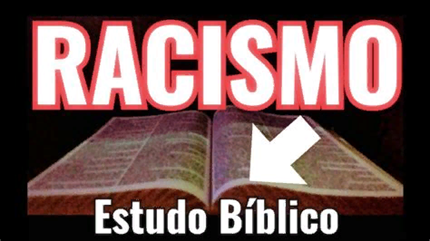
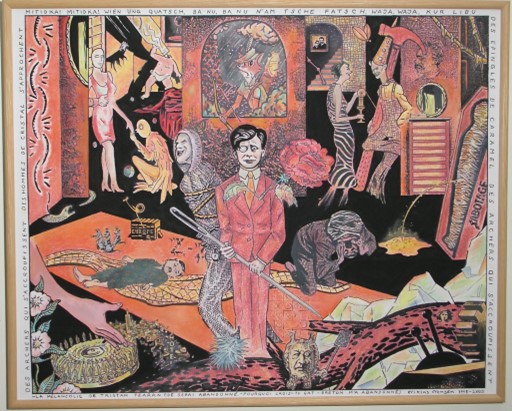 Tristan Tzara depicted in a contemporary painting
Tristan Tzara depicted in a contemporary painting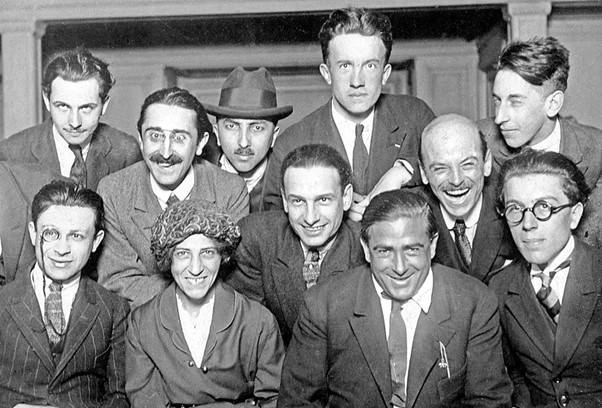 Tzara (bottom left) with other Dada artists in Paris 1920
Tzara (bottom left) with other Dada artists in Paris 1920 Left: Adolf the Superman: Swallows Gold and Spouts Junk by John Heartfield (Herzfeld) (1923). Right: ABCD by Raoul Hausmann (1923—24)
Left: Adolf the Superman: Swallows Gold and Spouts Junk by John Heartfield (Herzfeld) (1923). Right: ABCD by Raoul Hausmann (1923—24)
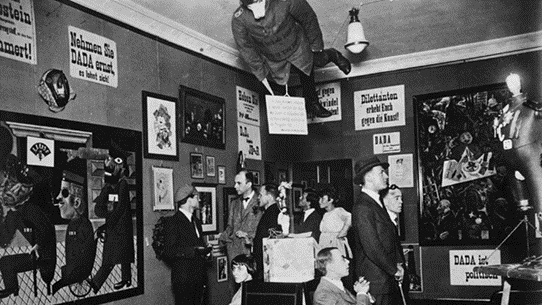 The First International Dada Fair in Berlin in 1920
The First International Dada Fair in Berlin in 1920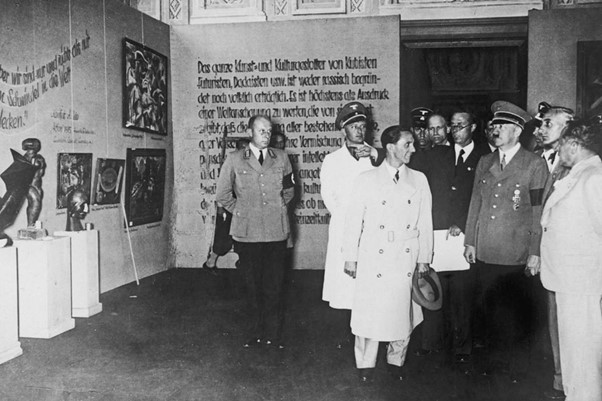
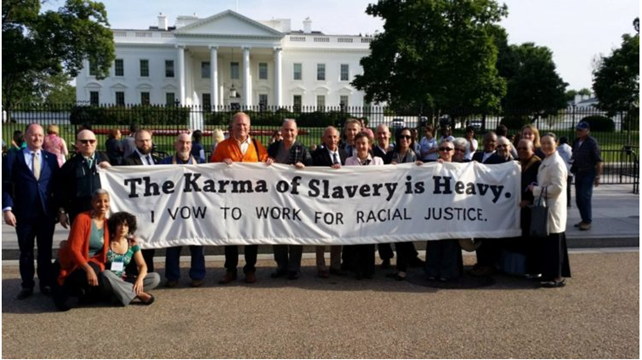 De façon quasi prémonitoire, cet article d’Andrew Joyce examine l’orientation imprimée au Bouddhisme moderne par les Juifs en Occident et dans le monde, influence qui semble culminer dans l’actualité avec la photo scandaleuse du Dalaï Lama avec un jeune garçon.
De façon quasi prémonitoire, cet article d’Andrew Joyce examine l’orientation imprimée au Bouddhisme moderne par les Juifs en Occident et dans le monde, influence qui semble culminer dans l’actualité avec la photo scandaleuse du Dalaï Lama avec un jeune garçon.